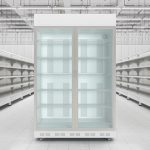Tips For Organizing a Commercial Fridge or Freezer
 Tips For Organizing a Commercial Fridge or Freezer
Tips For Organizing a Commercial Fridge or Freezer
Organizing a commercial fridge or freezer can be a daunting task, especially when you are handling a busy kitchen or retail environment. However, a well-organized fridge or freezer is crucial for maintaining food safety and efficiency. In this blog post, we will discuss some tips for organizing a commercial fridge or freezer.
1. Keep Categories of Food Separate
One of the essential things that you need to do when organizing a commercial fridge or freezer is to keep the categories of food separate. For example, you should keep raw meats separately from cooked meats and seafood to prevent cross-contamination. Similarly, you should store dairy products away from meat products.
To make it easier to keep food categories separate, you can assign zones or areas within the fridge or freezer according to food type. For example, you can assign one storage area to produce, another area to meats and poultry, and so on. Labeling shelves or sections can also be a helpful way to make sure everyone knows where things go.
2. Label and Date Everything
Labeling and dating everything in the fridge or freezer is crucial for keeping track of inventory and for food safety. When labeling bottles and containers, include the date of the product and use-by dates. You should then store products with the earliest use-by dates at the front of the fridge or freezer, so they are used before expiry.
Using labeling software can help make the labeling process more efficient and make checking the product dates easier. It’s always best to err on the side of caution when it comes to food safety, so don’t hesitate to throw things away if they’re expired.
3. Use Proper Storage Containers
Proper storage containers are crucial for maintaining food safety and preventing spoilage. Plastic containers with tight-fitting lids are ideal for storing dry ingredients or wet ingredients that should stay dry, like prepped fruits or vegetables. Glass or metal are great options for anything acidic (like citrus) or for hot ingredients.
Vacuum-sealed bags or containers with an airtight seal are a great option for storing marinated meat or other items that need to be packed tightly. You can also use plastic wrap to seal items like deli meats or cheeses.
4. Use Racks and Shelving
Using racks and shelving in the commercial fridge or freezer can maximize storage space and make it easier to organize items. Racks keep food off the ground and away from spills, while shelves can help maximize space.
The types of shelving you use will depend on the type of products you store. Wire racks or perforated metal shelves are best for allowing air to circulate, which helps keep produce fresh. Solid shelves are great for baking sheets or other flat items.
5. Schedule Regular Cleaning
Regular cleaning of the commercial fridge or freezer is essential for maintaining food safety and hygiene. Regularly clean and sanitize shelving, racks, and storage containers. Use a diluted bleach solution to sanitize, and regularly wipe down exterior surfaces with a commercial disinfectant cleaner.
Taking regular inventory of your perishable items and regularly throwing away anything that has expired is also part of the regular cleaning process. Make sure any spills are cleaned up immediately so as not to set a foul odor or attract pests.
Final Thoughts
Organizing a commercial fridge or freezer can be a challenge, but it is crucial for maintaining food safety and efficiency. You can follow the above tips to keep your commercial fridge or freezer organized and safe for your operation. Remember to keep categories of food separate, label, and date everything, use proper storage containers, use racks and shelving, and schedule regular cleaning. With these steps, you can maintain a safe and organized refrigerator or freezer in your commercial kitchen or retail environment.
